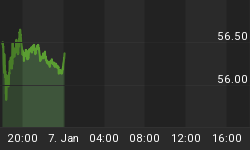Consumer spending has been strong during the first two months of the year. It appears that consumer spending slowed in March. Most retailers will report March sales results on Thursday. The ICSC forecasts that chain store sales increased 2% - 2.5% in March. This would continue the deceleration from January sales, which increased 5.0%. It would also be the lowest increase since last April. The shift of Easter into April this year and the bad weather experienced in March are the two most common reasons for the low predictions. This week, Johnson Redbook reported that same store sales increased 1.7% in March. This was the slowest gain since May 2005. Additionally, Wal-Mart reported that March sales rose 1.3%, which was slightly above the low end of its guidance of 1-3%. This was also the lowest increase since April 2004. Merrill Lynch noted that when Easter shifts into April, Wal-Mart's April same store sales are 6% better then in March. It should also be remembered that retail sales were up 5.0% in January and retailers had put out spring merchandise earlier this season. This will likely weigh on retail sales as well.
March auto sales were slightly weaker than analysts expected. Vehicle sales dropped in March to 16.6 million units from 16.8 million last year. Similar to the trend over the past few years, the Asian automakers gained share from the Big Three. General Motors reported that its sales were 15% below last year and Ford's sales were 4.6% lower. Toyota was one of the few that reported a strong month. Its sales were 6.9% higher than last year. Throughout this year, GM will be launching its new large truck and SUV line. It has already launched the new Yukon/Tahoe and Escalade models. These models did show positive sales momentum. Sales jumped 20% for the Tahoe and 45% for the Escalade. While it is important for GM to increase sales, it will need to sustain higher sales and the market is moving away from large SUVs. Large SUVs sales dropped 19.2% year-over-year. This is a market where GM has a 58% market share. Conversely, the fastest growing market is the crossover utility vehicles (CUVs). Sales of CUVs were up 12.6% last month. GM only has about 17% market share, while the Japanese automakers have 46%.
The manufacturing sector showed signs of slowing in March according to the most recent ISM report. The Purchasing Managers Index dropped 1.5 points to 55.2. The biggest declines were in new orders and employment, down 3.5 to 58.4 and down 2.5 to 52.5 respectively. Prices (+4.0 to 66.5) and backlog (+5.0 to 59.5) had the largest increases. Most of the components of the survey remained above 50, so the manufacturing sector continued to expand, just at a slower pace. After four years of expansion, slowing economic activity should be expected.
The non-manufacturing sector ticked up slightly in March. The non-manufacturing ISM survey rose 0.4 points to 60.5. New orders accounted for most of the increase, increased 3.3 points to 59.5, highest since December. Employment and prices had the biggest drops. Employment fell 3.6 points to 54.6 and prices fell 4.3 points to 60.5, the lowest since February 2004. While that might sound like pricing pressures are easing, the index remains significantly above the 50 that marks the neutral point. It has been above 60 every month since March 2004. The booming global economy is helping export orders. New export orders rose 3.5 points to 63.5, matching the highest level ever reported.
Best Buy reported earnings for its fourth quarter. Revenue increased 16%, the largest increase in two years. Same store sales increased 7.3% during the quarter. Sales were driven by a 17.7% increase in consumer electronic comps. While flat panel television prices dropped about 20%, units were up triple-digits. Appliances were up 5.5% due mostly to higher ticket prices. Home office comps were only 2.5% with double-digit gains in notebooks offset by declines in printers and telephones. Entertainment software comps dropped 4.5% due to declines in DVDs and CDs. For those planning on buying a television this year, Best Buy expects the price decline to decelerate, but with most of the decline happening during the second half of the year. Gross margins increased 143 basis points, helped my lower markdowns and a less promotional environment.
The National Association of Realtors reported that the increase in home sales was almost entirely due to the purchase of second homes, either vacation homes or homes purchased as an investment. Home purchased as an investment rose 15.7% and accounted for 27.7% of all home purchases. Sales of vacation homes rose a similar 16.9% and were 12.2% of the market. Homes purchased as a primary residence only increased 0.9%.
There were two smaller homebuilders that reported new orders for the first quarter this week. William Lyon Home reported that new orders declined 26%. California orders dropped 33%. Its cancellation rate increased from 12% to 28%. Brookfield Homes reported an even steeper decline of 56%. Sales plummeted in its San Diego/Riverside and Washington D.C. markets, declining 75% and 66% respectively.
Ten-year rates have jumped from about 4.7% to 4.85% over since the Federal Reserve met last week. The employment report on Friday will likely provide the next catalyst for rates to continue higher or to reverse. Economists expect payrolls to increase by 190,000, which is lower than the 243,000 created last month. The past couple of months the Labor Department has not provided very clean reports. It seems that if more jobs were created than economists forecasted, the revisions for the previous months offset the better number. This week, Treasury Secretary Snow said that he thinks "they will be good numbers."















